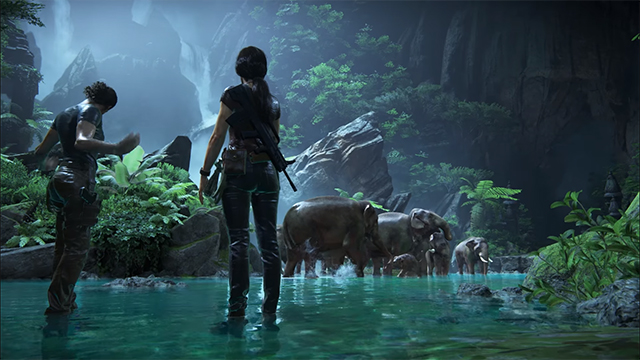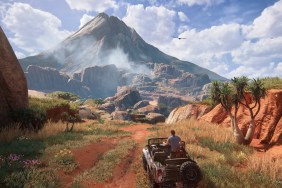Similar to the giraffe scene in The Last of Us, Uncharted: The Lost Legacy’s serene elephant section was a standout part in a game full of noteworthy moments. Peace and quiet does wonders for an action-filled game such as this but using elephants to achieve that softened tempo was as clever as it was effective. And while it seemed like a fairly simple scene — it’s only about six minutes of actual playtime — Naughty Dog repeatedly ran into walls getting it to where it need to be. But with some determination, consulting, and relentless testing, the team turned a troubled idea with potential into something special.
The base idea having elephants in the game is not a controversial feature. Marianne Hayden, story animator at Naughty Dog, stated during her GDC talk that the elephants were originally placed far off in the distance in the wide-open Western Ghats level near the beginning of the game. But players were not content with just looking at elephants off in the distance; they wanted to interact with the big trunked mammals.
So the team moved the herd closer into the gameplay space and naturally, players took notice. Testers were driving right up to the elephants, jumping around, and generally being a nuisance. But good intent was (usually) there and these people wanted more. They wanted to “pet them and feed them and ride them.” And Naughty Dog obliged.
Horsing around in Uncharted: The Lost Legacy
The team added in the ability to pet an elephant calf and even climb on top of and ride the elder ones using the same tech that was used in Uncharted 3’s horse sequences. It was colloquially called “Horton,” a reference to the classic Dr. Seuss book and the tech’s filename that was carried over from Uncharted 3, “Horse10.”
But this, as you could imagine, was ridiculous. Petting a baby elephant isn’t too outrageous but doing that in front of its parents without getting to mauled to death was incredibly unrealistic. Hayden demonstrated this by showing a picture of a real-life car that had been crushed by an elephant. It was totaled and proved how strong and hostile these seemingly docile beings could be. Even members of the team, including the game’s own director, thought the concept was dumb and silly. Something had to change but people desperately wanted to ride the elephants.
“Once we allowed the player to ride the elephant, there was no going back,” Hayden admitted. “Because who doesn’t want to ride an elephant?”
There was enough demand for rideable elephants that Naughty Dog chose to seriously explore the issue instead of trashing it because it was initially unrealistic. To help bring this idea to a more structured and cohesive state, Naughty Dog talked to an animal welfare consultant and cultural advisor. But despite wanting to do it correctly, their advice put the team in an even more restrictive box.
How Naughty Dog combines story and gameplay
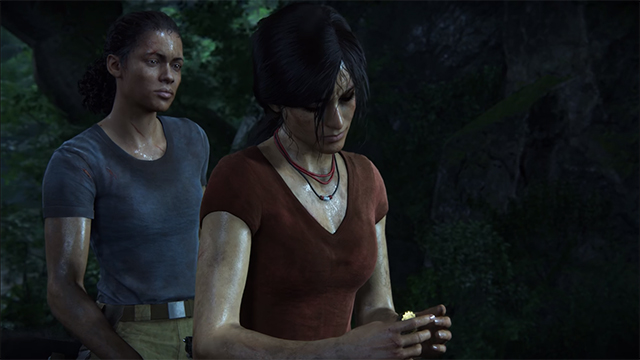
It shouldn’t be surprising but you can’t just walk up to any wild elephant and ride it like a disciplined horse. And if you could, it would suggest that the animal was trained and most likely abused during that process. This meant that the team had to find more creative ways to realistically get the player on the elephant in way that also wasn’t furthering harmful rhetoric. Naughty Dog didn’t just want it to be a throwaway moment just for thrills either; it had to feed into the story. Hayden explained how it fit in with the team’s overall goal it has for each of its games.
“Design at Naughty Dog influences story and story often influences design,” she said. “Story and gameplay are developed in concert. One often does not come without the other. Naughty Dog frequently creates scripted sequences where the player has limited control and still allows to deemed a cinematic moment and these moments in games are always more emotional and have more impact when someone is on the stick unlike cutscenes. This can present challenges.”
This meant that the design and story groups had to collaborate to hash out how the player would find and get on an elephant in a believable way that worked with the narrative and within the mechanics. At this stage, the elephants moved from the Western Ghats in the beginning to a spot near the end where the antagonist had set off a bunch of explosions. Boom. There was a convincing way to trap an elephant and possibly ride one that had naturally presented itself.
Breaking the camera
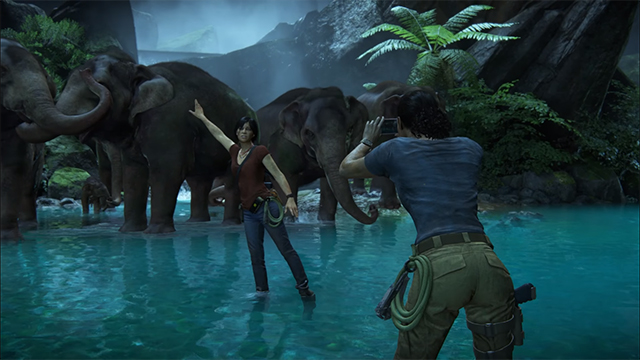
But even this had issues. Here, players were tasked with climbing around and knocking over debris to clear a path for the elephant. This was scrapped and then changed to also allow the player to ride the elephant through the newly cleared route. In essence, you open up a path for the elephant so it can help you progress through the level. However, this meant the creature would have to kneel to allow you to get on it, which circled back to the domestication issues from earlier. Close but not quite.
Successful elements carried over between iterations. Moving rubble for the elephant proved itself and had potential; it just needed to be applied in the right scenario. And that’s when Naughty Dog found it. By placing the rubble on the elephant, it gave the player an excuse to physically get on top of the beast in order to remove it. It was grounded enough to be feasible yet still achieved the goal of let players ride that damned elephant. Mission accomplished.
Well, partly accomplished. This viewpoint broke the game’s camera as it would either clip through the beast’s butt or head, which required a new camera splining system that took extra work. Keep in mind that this whole game was made in about a year and every setback and extra step was costing the team time it almost didn’t have.
The big, hairy butt
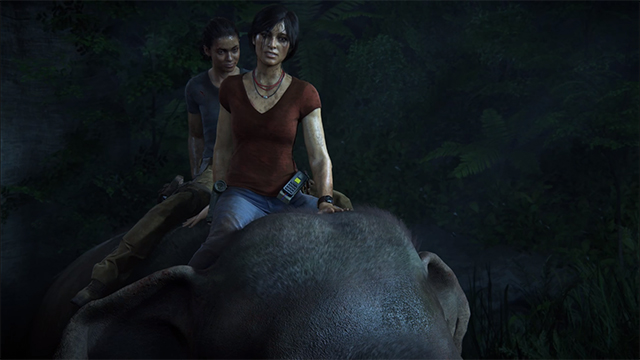
After addressing the camera, Naughty Dog had to figure out what to do with the player now that they were finally on the beast. Directly controlling the animal was the first step but ended up feeling like a horse. This led to Naughty Dog mostly stripping away player control, which ended up with a bunch more increasingly granular, tedious challenges. These included correctly framing the monkeys in the background in order to get a smooth transition to the cutscene, temporarily taking the player’s rifle away to away to avoid clipping, and making sure Claudia Black (Chloe’s voice and mocap actor) wasn’t leaning forward with her elbows on the elephant because it looked like she was “resting on a big, hairy butt” during certain shots. But despite these issues, it was getting there.
Most of the scene wasn’t a cutscene and that meant players could shoot their guns. Immersion would fly out the window and it would rob the scene of its beauty. Taking away their weapons took away interactivity; an aspect Naughty Dog wanted to keep. This led to the fruit branches you could grab and feed to the elephant while sitting on top. It’s small and optional, but it is something and meshes with Naughty Dog’s aesthetic of having cinematic moments with some player agency.
Once all of those straightened up, there was just one more issue left in order to stick the landing: actually sticking the landing. Elephants don’t jump, which made it hard to get it to the final jump where the player is knocked off the top. At first, the cliff it fell off was pretty steep and the pond was shallow. Naughty Dog fixed this by making the cliff shallow and the pond deep. This way it would be believable that an elephant would be able to safely make this hop while also bumping the player off into the water.
Once the player takes control of Chloe, Naughty Dog wanted one more way to remember the elephants but, again, in a way that stayed true to reality. So in addition to letting users pet the elephant while riding it, Naughty Dog added the ability to take a photo near the elephants from a safe distance. It fit in with the multiple other picture locations in a way that the players could cherish since said pictures get stored on Chloe’s phone.
And that was it. After months of work and multiple iterations, the sequence was complete. Naughty Dog only got players to ride an elephant but did so in a believable, graceful way that housed an important character moment. This process proved Hayden’s point of how vital it is for developers to take time to explore options within the design and story and iterate enough times to get it right. This work and synergy paid off because it’s one of the best moments in the game that will also hopefully be a valuable lesson for other developers. And if not, those studios will likely get another learning opportunity for whatever cute mammal moment that’ll probably appear in The Last of Us 2.
